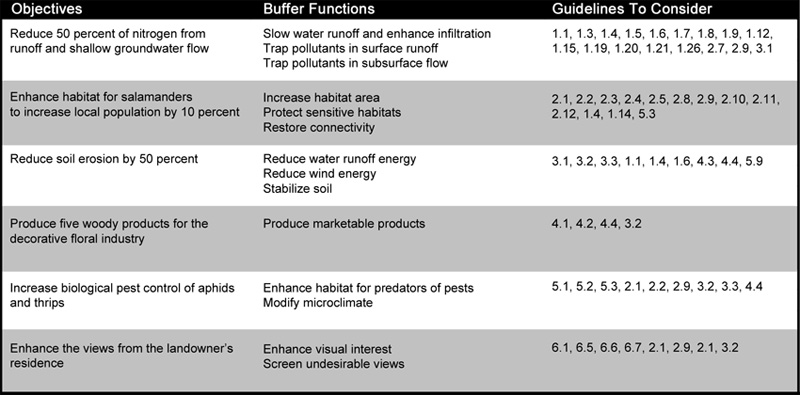HOW TO USE THIS GUIDE
This guide provides science-based guidelines for designing buffers. The guidelines are organized into seven resource sections:
- 1.0 Water Quality
- 2.0 Biodiversity
- 3.0 Productive Soils
- 4.0 Economic Opportunities
- 5.0 Protection & Safety
- 6.0 Aesthetics & Visual Quality
- 7.0 Outdoor Recreation
- Borrowing Images
A simple step-by-step process is suggested for using the guide effectively.
Using the Buffer Design Guidelines
- Identify resource issues of concern
- Select desired buffer functions for each issue from Table 1
- Refer to the resource section for guidelines that address each desired buffer function
- Prepare a preliminary buffer plan or design
- Refine the plan using other resources as necessary
1. Issues of concern and related objectives should be identified with assistance of the landowner or stakeholder group using a planning process. Record the objectives (see Table 2 for an example).

Table 2 � Example table used to organize a project�s objectives, the desired buffer functions, and the applicable design guidelines
2. Based on the identified issues and objectives, select the appropriate buffer functions from Table 1 and record these functions (see Table 2 for an example).
3. Refer to each resource section and select guidelines that address the desired buffer functions using the guideline-function matrix (fig. 5). Use the additional design guideline-function matrix (fig. 6) to identify guidelines in the other resource sections that may be useful. Record the guideline numbers (see Table 2 for an example).
4. Use the selected guidelines to prepare a preliminary buffer plan. Compromises and trade-offs may be necessary to address all of the objectives and buffer functions.
5. Optional step: Refer to the referenced publications used to develop the guidelines. The online version of this guide provides over 1400 references (www.bufferguidelines.net). These publications may provide additional design information, including more detailed design criteria for specific geographic regions. Use other printed and Web resources, experts, and personal experience to refine the buffer plan.
Implement the plan and monitor the results over time. Make adjustments to the buffer design and future buffer plans based on the monitoring.
Figure 5 — An example of a guideline-function matrix. |
Figure 6 — An example of an additional design guideline-function matrix. |

